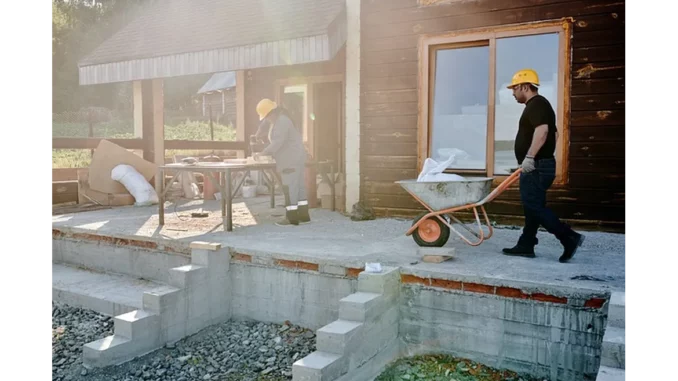
When it comes to retrofitting properties, especially those with historical significance or located in conservation areas, planning can become a maze of permissions and regulations. Recently, I had the opportunity to sit down with Abigail Norton, a project manager for a prominent housing association, to discuss her experience in navigating these waters. Her insights shed light on the importance of meticulous planning and the critical steps needed to ensure a smooth retrofit process.
Focus360 Energy: property compliance services – pre-planning to post-construction. Learn more.
“Anticipating the Unanticipated”
Abigail Norton, with her astute eye for detail and a knack for forward-thinking, began our conversation by emphasising the importance of anticipating potential planning constraints from the very start. “When you’re dealing with retrofit projects, especially in protected areas, it’s not just about knowing the rules but understanding how they apply to your specific situation,” she said.
Her association recently undertook a substantial retrofit project involving a series of Victorian terraced houses in a designated conservation area. “We were excited about the project, but we knew we had to tread carefully,” Abigail remarked. “The first thing we did was to consult the local development plan.”
“Consulting the Local Development Plan”
Local development plans are the cornerstone for understanding planning constraints. Abigail highlighted the necessity of this step. “Every local authority has its own development plan that outlines the framework for making planning decisions. For us, it was crucial to align our project with the aims and objectives of the local plan,” she explained.
In her case, the local authority’s plan had a strong emphasis on conserving the architectural heritage while promoting energy efficiency. “It was a balancing act,” Abigail continued. “We had to demonstrate how our retrofit would cut emissions without compromising the historical integrity of the buildings.”
“Understanding Permitted Development Rights”
One of the more reassuring aspects of retrofit projects is that many types of work fall under permitted development rights, meaning they do not require planning permission. However, as Abigail pointed out, this isn’t always the case. “Permitted development rights might not apply if the properties are listed or in a conservation area,” she noted.
To navigate these nuances, Abigail’s team applied for a Lawful Development Certificate. “It was a proactive step to ensure our planned works didn’t require additional permissions,” she said. This certificate provides legal confirmation that the proposed development is within the permitted development rights, a step that can save time and avoid future legal complications.
“Engaging with the Planning Authority”
Early engagement with the local planning authority is another critical step. “We made it a point to have an early conversation with the planning team. This helped us understand the specific requirements and the process for securing permissions,” Abigail recounted.
Such discussions can highlight potential issues early on, allowing for adjustments to be made without significant delays. “The local authority also offered a pre-application service, which was incredibly valuable. It provided us with tailored advice on making our buildings more energy-efficient within the planning constraints,” she added.
“Allocating Time and Resources”
One of the most pivotal pieces of advice Abigail shared was the importance of allowing sufficient time and resources for the planning process. “Planning permission and listed building consent can take anywhere from 8 to 16 weeks to process. This needs to be factored into your project timeline right from the start,” she stressed.
For her project, this meant adjusting the delivery plan to accommodate these timelines. “We also had to consider the costs associated with the planning applications and include them in our business plan. Overlooking these can lead to budget overruns and project delays,” she warned.
“Building the Right Team”
Having the right team in place is another cornerstone of a successful retrofit project. “We appointed consultants who specialised in planning, heritage, and ecology. Their expertise was indispensable in meeting the strict requirements for our planning application,” Abigail stated.
Each project may require different consultants, but having professionals who understand the local planning landscape can make a significant difference. “Their input helped us prepare a comprehensive application that met all the necessary criteria, reducing the likelihood of delays,” she noted.
“Securing Permissions Before Starting”
Abigail’s final piece of advice was unequivocal: ensure all necessary permissions are secured before commencing any work on site. “Starting without the requisite approvals can lead to legal action, fines, and even the need to undo completed work,” she cautioned.
In her project, all planning approvals were meticulously checked and confirmed before any work began. “We couldn’t afford the risk of having to reverse our work, especially given the historical significance of the buildings,” she said.
“Communication is Key”
Lastly, managing expectations of residents and stakeholders is vital. “We kept the residents informed throughout the process, letting them know about the planning applications and the need for access to their homes for assessments,” Abigail shared. “This transparency helped avoid surprises and ensured cooperation.”
Abigail Norton’s experience underscores the complexity and importance of careful planning in retrofit projects. By consulting local development plans, understanding permitted development rights, engaging with planning authorities, allocating sufficient time and resources, building the right team, and securing all necessary permissions, her team navigated the planning constraints successfully. For anyone embarking on a similar journey, her insights serve as a valuable guide.
Tobiasz Karcz


Be the first to comment